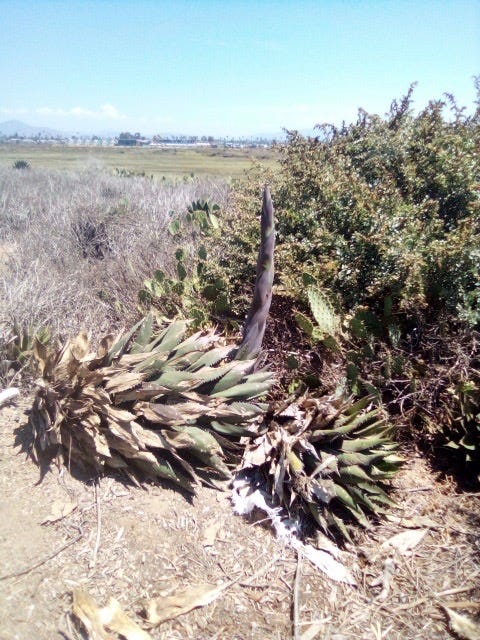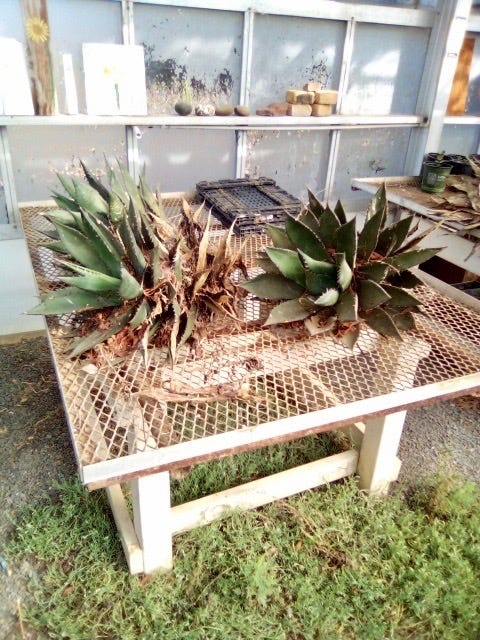“Hey, Paul, that Shaw’s agave that we took out a couple weeks ago is starting to bloom.”
That was Ralph, the intern who has been working with me over the last several months. It was the end of the day on Monday, when Ralph ran across the soon to be blooming agave. When I went over to take a look, sure enough, there it was laying on its side, with the characteristic asparagus stalk growing from its crown.

.
I had to remove the plant because it had grown over a small wall. The plant’s many barbs presented a hazard to folks walking by. The Shaw’s agave is a flowering plant, but it also reproduces by making clones of itself, pups alongside the parent plant. When I remove an agave, I leave the “family” of the agaves intact, only removing one or two of the clones.

The range of the Shaw’s agave and where you can find them now
There are two subspecies of Shaw’s agave. One that grows in the Mexican desert, and this one, the coastal one (Agave shawii subsp.shawii). In the above map, the dot along the coast indicates the only place in San Diego County, or the U.S. for that matter, where the Shaw’s agave still naturally occurs. That bit of land that juts out into the ocean like the trunk of an elephant is called Point Loma. The side of Point Loma facing the ocean is a promontory, a cliff that plummets straight down to the Pacific Ocean. The agaves occupy a patch of land at the edge of this promontory. Many of the agaves cling precariously to the edge of that cliff.
The other dot, along the bay, indicates where I work* and where I have a plethora of agaves. The plant’s historic natural range would have been from about ten miles north of La Jolla on south, occupying the five to seven miles of land inland from the coast. Agaves have been extirpated from this area primarily because most of the natural landscape has been paved over for housing development, strip malls, and highways. There are places south, down along the Baja coast, where there are still natural stands of Shaw’s agave, but if you see it anywhere in the U.S., it’s been planted there by somebody.
Whenever I remove a Shaw’s agave, I try my best to replant it. And I’ve replanted dozens of agaves. It’s pretty easy. All you have to do is ensure that the base of the plant is in contact with the earth. The agave will send new roots out. They are particularly hearty. I’ve kept them on a shelf or table for weeks before replanting them, and they still take root. Also, most of the time that I remove an agave, I need someone to help me. They often weigh over 100 pounds. For the folks helping me I have to warn them that not only are the barbs of the agave very sharp, but the juice inside the leaves is very caustic. I’ve gotten some on my arms, and it was like having a second degree burn for over a week.
On the brink but still found in nurseries
An agave might live for 20, 30, sometimes 80 years before it blooms and dies, earning them the nickname “the century plant.” I think that is why the one I removed is blooming. Having been cut off from its clone home and not rooted, it sensed that it was going to die, so it triggered its bloom. The “asparagus” stalk may grow to 15 feet before flowers emerge. In Mexico the agaves are pollinated by Mexican long-tongued bats, lesser long-nosed bats, and pallid bats. People monitoring the Shaw’s agaves on Point Loma say that the plants bloom but no new agaves are being produced from sexual reproduction, and no new sprouts have cropped up since 2008. They have recorded eleven species of bats in the area, but none of the species is pollinating the agaves. Moths and other insects are attracted to the plant’s nectar, but pollination remains unsuccessful.
Thus the precarious status of the Shaw’s agave. There is one natural patch of them in the U.S., and that patch could die out. I found neither a federal listing for the plant, nor one from the International Union for Conservation of Nature. But Shaw’s agave are classified by the California Native Plant Society as 2B.1, a designation meaning that the plant is “rare, threatened, or endangered in California but more common elsewhere.”
The irony I experience is that I have too many Shaw’s agave. I’m running out of places to put them. I try to give them away, but folks don’t seem eager to pick them up.
Further complicating the picture, horticulturists and gardeners have found that Shaw’s agaves can be successfully hand pollinated—no bats needed—and successfully grown in greenhouses. They are available at nurseries. Most of the nurseries where I found the plant are in southern California, including a nursery in Santa Barbara, north of Los Angeles, but I also found that the Horticulture Department at Oregon State University lists it as a landscape plant.
So what to make of this? A plant that has been almost completely extirpated from its natural landscape, that may no longer be reproducing in the wild (at least in the U.S.), that is nonetheless being grown by gardeners and planted by landscapers, even in places that are far from its original range, may have a future as a “captured cultivar,” one that survives, not because of any conservation efforts, but because people want to have a large succulent in their front yard.
And I’m still trying to give a few of the plants away.
For more environmental science & news follow me on Twitter @EcoScripsit.
*I am a horticulturist at a small zoo in Chula Vista, California.






Paul, this is a spot where I used to feed some kitties. In the alley here was a huge agave. Which kind is this? https://maps.app.goo.gl/P163QYgkfnzt7z896